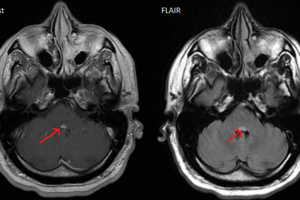Benign positional vertigo (BPV; AKA benign paroxysmal positional vertigo or BPPV) is a common cause of dizziness characterized by sudden onset of dizziness with position change that resolves in 20-30 seconds.
Clinical presentation of benign positional vertigo
- Presents with complaints of lightheadedness, dizziness, vertigo, and nausea
- Symptoms precipitated by changes in head position (eg, rolling over in bed or looking up)
- 50% of dizziness in older people due to BPV
- Thought to be caused by displaced utricular otoconia in semi-circular canals
- Most common is posterior canal BPV: reclining or head extension causes vertigo (“top-shelf vertigo”)
Dix-Hallpike maneuver for diagnosis of BPV
- Upward nystagmus when patient is reclining (head extended back 20◦ and tilted at 45◦)
- Downward nystagmus when sitting up
{youtube}hq-IQWSrAtM{/youtube}
Canalith repositioning procedure as treatment for benign positional vertigo
- “The Epley maneuver”
- Usually a definitive treatment (~80% success)
- Brandt-Daroff exercises
- Similar to Epley maneuver
- Patient lies down on side
- Head tilted 45◦ for 30s
- Switches to the other side


